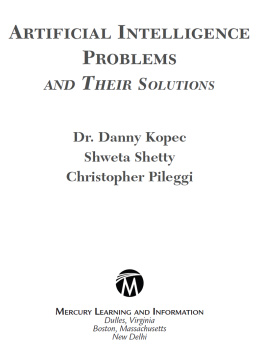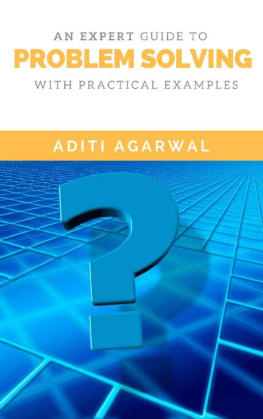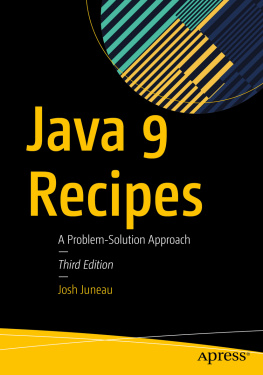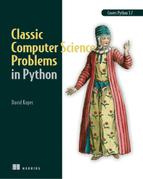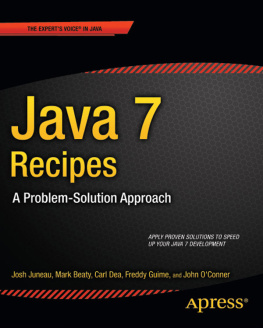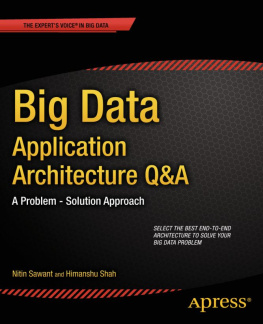
A RTIFICIAL I NTELLIGENCE P ROBLEMS AND T HEIR S OLUTIONS
License, Disclaimer Of Liability, And Limited Warranty
By purchasing or using this book and disc (the Work), you agree that this license grants permission to use the contents contained herein, including the disc, but does not give you the right of ownership to any of the textual content in the book / disc or ownership to any of the information or products contained in it. This license does not permit uploading of the Work onto the Internet or on a network (of any kind) without the written consent of the Publisher. Duplication or dissemination of any text, code, simulations, images, etc. contained herein is limited to and subject to licensing terms for the respective products, and permission must be obtained from the Publisher or the owner of the content, etc., in order to reproduce or network any portion of the textual material (in any media) that is contained in the Work.
M ERCURY L EARNING AND I NFORMATION (MLI or the Publisher) and anyone involved in the creation, writing, or production of the companion disc, accompanying algorithms, code, or computer programs (the software), and any accompanying Web site or software of the Work, cannot and do not warrant the performance or results that might be obtained by using the contents of the Work. The author, developers, and the Publisher have used their best efforts to insure the accuracy and functionality of the textual material and/or programs contained in this package; we, however, make no warranty of any kind, express or implied, regarding the performance of these contents or programs. The Work is sold as is without warranty (except for defective materials used in manufacturing the book or due to faulty workmanship).
The author, developers, and the publisher of any accompanying content, and anyone involved in the composition, production, and manufacturing of this work will not be liable for damages of any kind arising out of the use of (or the inability to use) the algorithms, source code, computer programs, or textual material contained in this publication. This includes, but is not limited to, loss of revenue or profit, or other incidental, physical, or consequential damages arising out of the use of this Work.
The sole remedy in the event of a claim of any kind is expressly limited to replacement of the book and/or disc, and only at the discretion of the Publisher. The use of implied warranty and certain exclusions vary from state to state, and might not apply to the purchaser of this product.
A RTIFICIAL I NTELLIGENCE P ROBLEMS AND T HEIR S OLUTIONS
Dr. Danny Kopec
Shweta Shetty
Christopher Pileggi

Copyright 2014 by M ERCURY L EARNING AND I NFORMATION LLC. All rights reserved.
This publication, portions of it, or any accompanying software may not be reproduced in any way, stored in a retrieval system of any type, or transmitted by any means, media, electronic display or mechanical display, including, but not limited to, photocopy, recording, Internet postings, or scanning, without prior permission in writing from the publisher.
Publisher: David Pallai
M ERCURY L EARNING AND I NFORMATION
22841 Quicksilver Drive
Dulles, VA 20166
www.merclearning.com
1-800-758-3756
D. Kopec, S. Shetty, & C. Pileggi. Artificial Intelligence Problems and Their Solutions.
ISBN: 978-1-938549-83-0
The publisher recognizes and respects all marks used by companies, manufacturers, and developers as a means to distinguish their products. All brand names and product names mentioned in this book are trademarks or service marks of their respective companies. Any omission or misuse (of any kind) of service marks or trademarks, etc. is not an attempt to infringe on the property of others.
Library of Congress Control Number: 2013957999
141516321
Printed in the United States of America
This book is printed on acid-free paper.
Our titles are available for adoption, license, or bulk purchase by institutions, corporations, etc. For additional information, please contact the Customer Service Dept. at 1-800-758-3756 (toll free). Digital versions of our titles are available at: www.authorcloudware.com
The sole obligation of M ERCURY L EARNING AND I NFORMATION to the purchaser is to replace the book and/or disc, based on defective materials or faulty workmanship, but not based on the operation or functionality of the product.
We live in times that are transitional and fast-paced. Just about everyone seems to own at least one electronic device, such as iPhones, smart phones, notebooks, and so on, that they consider vital to their existence. Patience is short, and everyone wants quick results (e.g., Google) without having to do a lot of difficult research. Students come to classes unabashedly deploying these devices, and instructors dont know if theyre text messaging/social networking, or addressing the topic at hand. Attention spans seem to be very short. We are consistently distracted by the small things that need to, or can, be done. In the end, our lives seem to be made up of small, choppy episodes as we go about conducting our daily tasks. The notion that one sits still at a desk uninterrupted for many hours seems foreign to our society today. Persistence, trial and error, search, inquisitiveness, and simply thinking appear to be activities of the past. And it is clear that there will be no turning back from this technological age and our dependencies on technology. Yet, over and over again, we hear that our childrens test scores are declining.
One perspective on intelligence measures the ability to solve problems. Another considers how an individual or a society is able to survive under adverse conditions. So the natural question is: what will happen to our society and our children if someone turns off the power?
Therefore, a book about solving problems that uses nontrivial and sometimes difficult problems is especially timely, because it addresses the needs of a number of possible constituent audiences. This book assembles in one place a set of interesting and challenging artificial intelligence (AI)type problems that students regularly encounter in computer science, mathematics, and AI courses. These problems are not new, and students from all backgrounds can benefit from the kind of deductive thinking that goes into solving them. Another constituent audience is the computer science, mathematics, or AI instructor who is looking for answers to these problems. This book explores the kinds of thinking, methods, and applications used in computer science and AI to solve these problems. Furthermore, a solid understanding of how amenable a solution is to humans (hence the notion of the Human Window) adds more depth to how the problems and their solutions can and should be presented. This book is also helpful to those who would like to improve their problem-solving skills. No doubt todays young people will soon discover that they are lacking in these basic skills, and this book will be one resource they can turn to for help practicing and enhancing their problem-solving abilities. Furthermore, there will be benefits from developing and maintaining life-long learning skills.
It must be emphasized that this book is not about solving problems quickly. Skillful problem solvingwhether learning to play chess, becoming a competent violinist, or reading this bookrequires time. So get ready to enjoy, learn, benefit, and grow!
Next page
